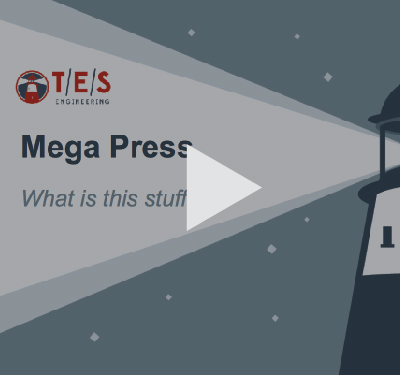

Breakfast Club: Mega Press
Posted by Bob Schneider on in Uncategorized
Mega Press is a new offering from Viega.
Slide 2
Viega is a method of joining piping, copper, stainless steel and plastics without solder or glue.
Slide 3
It uses hydraulic force to compress the fitting to the pipe and uses an “O” ring to seal the joint. The contractor buys the crimper with jaws for different pipe diameters.
Slide 4
Uses:
- where flame cannot be tolerated
- water is in the pipe
- variety of fluids and compressed air
Slide 5
Viega developed the same type of joining for black steel pipe, from schedule 5 to schedule 40. Pipe sizes from1/2 inch to 2 inches.
- One of the major advantages is that the pipe does not need to be threaded, which cuts away from the wall thickness of the pipe.
- It’s a quicker installation.
- Make sure the pipe ends are square and de burred.
- Insert fitting on pipe ends and crimp.
Slide 6
This system has a variety of elbows, tees, couplings, flanged connections, press to threaded adapters and unions.
Slide 7
The fittings are rated up to 200 psi, temperatures from -40F to 250F.
It can handle low pressure steam.
Viega offers 3 different “O” rings –
- EPDM for most applications
- HNBR for natural gas and higher temperatures
- FKM for use with chemicals
Need to verify the “O” ring with the application.
Slide 8
Note the yellow “O” ring insert for use with natural gas.
Slide 9
TES just completed a steam boiler project at St. Vincent de Paul church. The steam condensate pipe, some original for 1928, had patches installed where the pipe or threaded connections had failed. We needed to replace the piping on the lower level. Normal threaded schedule 80 pipe would be the standard specification. But it is labor intensive.
Working with Viega, we investigated using Mega Press as an alternate. The major concern was the “O” rings. Condensate can be corrosive and could damage the “O” rings over time.
Viega approved the application, IF, the condensate was treated to neutralize the pH.
Working with a local water treatment company, we added chemical steam injection and an oxygen scavenger to the steam and boiler. This insured that the condensate returning to the boiler was chemically neutral.
Slide 10
As steam condenses it naturally produces carbon dioxide and if they combine with non-condensable like air, carbonic acid is created. (As long as the condensate stays hot, carbonic acid does not form.) However, condensate piping is normally not insulated, only slightly sloped taking a longer time to return to the boiler. In the case of St. Vincent’s a vacuum pump was installed to help return the condensate by removing the air in the piping and creating a slight vacuum. Their vacuum pump was not working and the condensate cooled before returning to the boiler feed pumps. Carbonic acid formed and the corrosion caused leaks, which allowed the entrance of air, which led to a very acidic condensate system.
The standard pipe used for steam condensate is schedule 80, because it has a thicker wall and would last longer.
Slide 11
During our investigation, the addition of a steam treatment and an oxygen scavenger chemical would reduce the formation of carbonic acid, neutralizing the condensate. We replaced the vacuum pump and the damaged pipe sections, making the return condensate a tight system.
Viega approved of our steps which was protecting the “O” rings. The fittings would not fail, but the “O” rings could over time. Viega does not publish use of Mega Press on steam condensate for this reason. We provided a method of balancing the pH and were allowed to use this product for our project.

 Previous STORY
Previous STORY